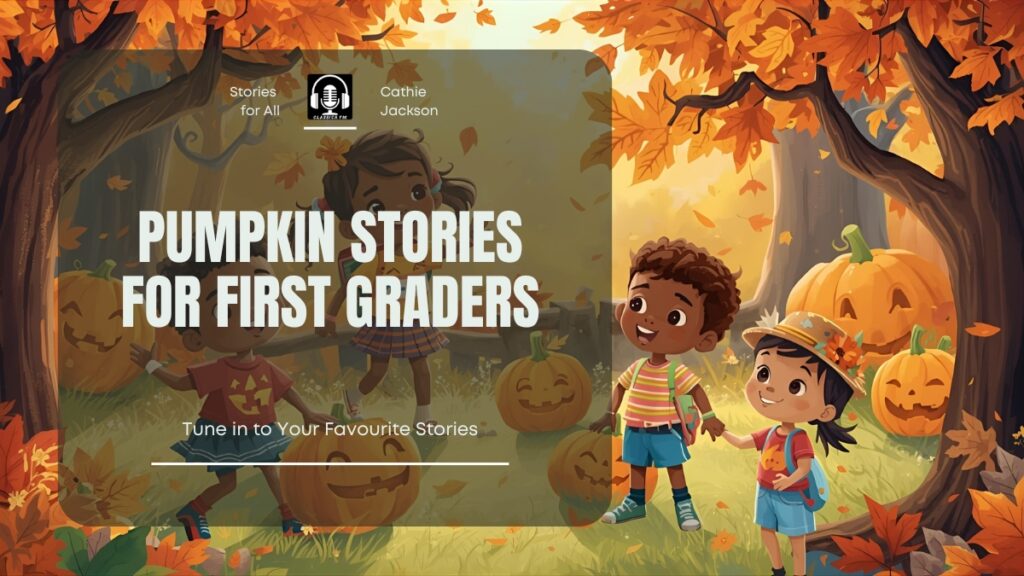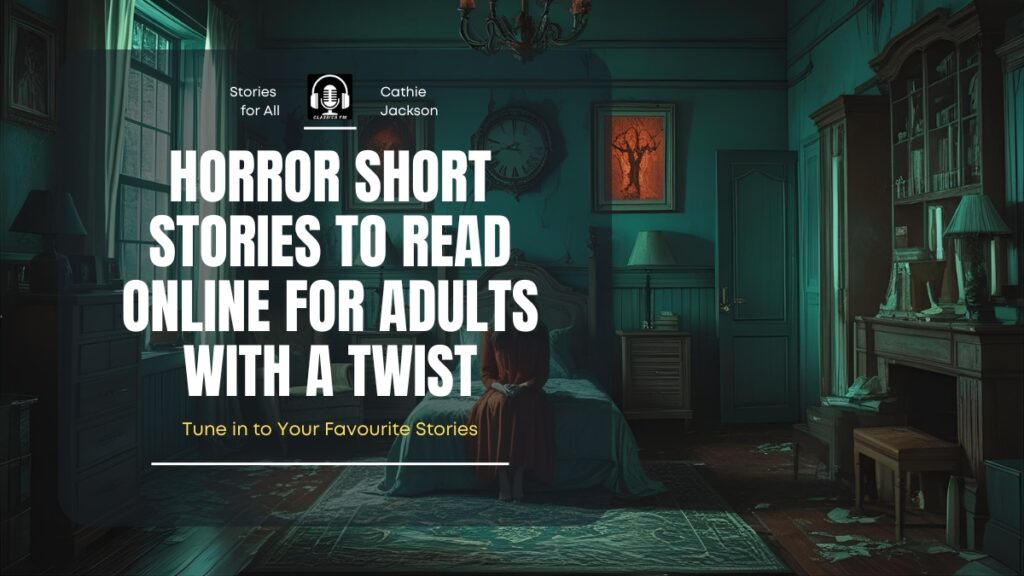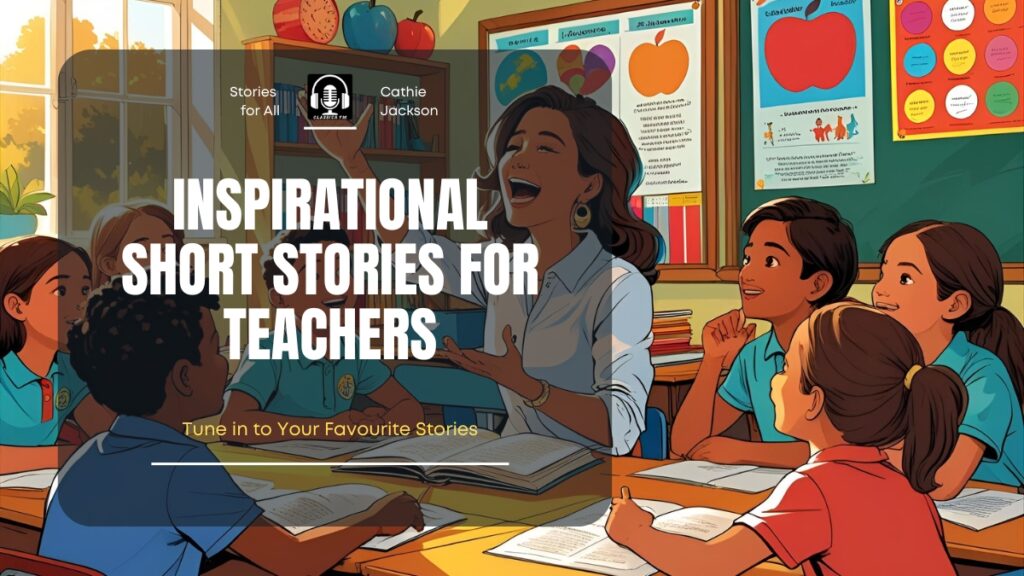Pumpkin Stories for First Graders help teachers teach reading, science, and math in one theme. These stories motivate young readers and give clear opportunities for hands-on learning.
Use this guide to choose books, plan lessons, and run classroom activities that match standards and student needs.
Why Pumpkin Stories for First Graders Work
Pumpkin Stories for First Graders connect seasonal curiosity with classroom skills. First graders respond to sensory detail.
They enjoy predictable language and strong images. A pumpkin theme also supports cross-curricular work.
Key benefits
- Boosts vocabulary through concrete nouns and verbs.
- Supports counting, measurement, and data recording.
- Links narrative comprehension with science inquiry.
- Encourages social skills through group projects.
Many teachers report higher engagement with themed units. Pumpkin units provide authentic tasks like planting seeds and measuring growth. These tasks make learning visible and measurable.
Pumpkin Stories for First Graders
Step into the magical world of pumpkins! These fun, heartwarming stories bring friendship, adventure, and autumn cheer to every first grader.
1. Pumpkin and the Flying Kite
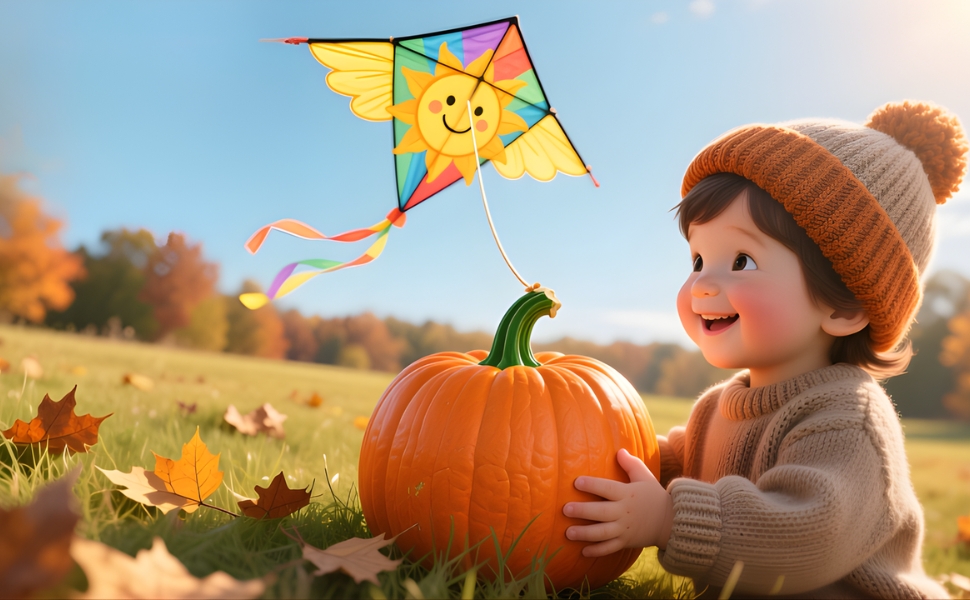
It was a bright, windy autumn morning.
In a small garden at the edge of town, a little pumpkin lay among the leaves.
It was round and orange, with a tiny green stem.
But this pumpkin was no ordinary pumpkin.
It had a big dream.
The pumpkin wanted to fly.
Every day, it watched the birds soar above the garden.
It saw the clouds drifting slowly.
It imagined what it would feel like to float in the sky.
“I want to fly too,” said the pumpkin softly.
The other pumpkins laughed.
“You’re a pumpkin,” they said.
“Pumpkins don’t fly.”
But the little pumpkin didn’t give up.
It rolled over to the edge of the garden and looked at the open field.
The wind whispered through the grass.
Maybe today would be the day.
At the same time, a little girl named Emma ran into the garden.
She carried a colorful kite.
The kite had stripes of red, yellow, and blue.
Emma loved to fly it every windy day.
She placed the kite carefully on the grass.
She tied the string to a small stick.
She ran across the field.
The kite rose into the air.
It danced and twirled in the wind.
The pumpkin watched in awe.
It wished it could join the kite.
The wind grew stronger.
It lifted the kite higher and higher.
The pumpkin felt a tug.
It wobbled forward.
It rolled slowly toward Emma.
Emma noticed it.
“Hello, little pumpkin,” she said.
She laughed at its round shape.
“Do you want to fly too?”
The pumpkin wiggled.
It nodded.
Emma thought for a moment.
Then she had an idea.
She carefully placed the pumpkin on the kite.
The pumpkin balanced on the kite’s frame.
“Hold on tight,” Emma said.
The pumpkin felt nervous.
The wind swirled around them.
The kite began to rise.
Up, up, and up it went.
The pumpkin’s tiny green stem quivered with excitement.
It looked down at the garden.
The leaves looked like tiny patches of gold and red.
The trees waved in the wind.
The houses looked like little toy boxes.
The pumpkin felt free.
It soared higher.
The wind lifted it gently.
The pumpkin giggled inside.
It was flying!
It twirled with the kite.
It dipped and spun.
The clouds brushed past its round orange body.
Birds flew alongside it.
They chirped and cheered.
“This is amazing!” thought the pumpkin.
Emma ran across the field, holding the kite string tightly.
She laughed with joy.
“You can really fly, little pumpkin!” she said.
The pumpkin felt happy.
It had dreamed of this moment for so long.
And now, it was true.
Hours passed as the pumpkin and kite danced through the sky.
They glided above the river.
They dipped over the hills.
They twirled above the town.
Children waved from below.
They had never seen a flying pumpkin before.
Even the grown-ups stared in wonder.
“This pumpkin is magical!” someone shouted.
The pumpkin felt proud.
It had achieved its dream.
But then the wind changed.
It became stronger.
The kite rocked and swayed.
The pumpkin held on tight.
It felt a little scared.
Emma noticed the change too.
“We need to land safely,” she said.
The pumpkin nodded.
Together, they carefully guided the kite down.
They floated above a soft meadow.
The grass cushioned their landing.
The pumpkin bounced gently on the ground.
It was safe.
Emma picked it up.
“You were amazing up there,” she said.
The pumpkin felt warm inside.
It had flown higher than it ever imagined.
It had seen the world from above.
And it had shared the adventure with a friend.
After that day, the pumpkin became famous in the garden.
Other pumpkins listened carefully as it told its flying story.
It shared the excitement of the wind.
It shared the thrill of soaring above the clouds.
It shared the joy of adventure and friendship.
Every pumpkin dreamed of flying after hearing the story.
But the little pumpkin knew something important.
Flying was fun, but friendship made it even better.
It had Emma to thank for helping it soar.
The next day, the pumpkin and Emma planned another adventure.
They gathered other small pumpkins from the garden.
They decorated them with ribbons and tiny scarves.
Each pumpkin got a small ride on the kite.
One by one, the pumpkins felt the thrill of flying.
The garden was full of laughter.
The children cheered.
Even the grown-ups joined in, holding the kites and helping the pumpkins fly.
The pumpkin learned that dreams could grow bigger when shared.
It realized that helping others fly was as joyful as flying itself.
Days passed, and autumn leaves continued to fall.
The pumpkin’s flying adventures became a tradition.
Every windy day, the pumpkins flew across the garden.
Birds joined them.
Children laughed.
Neighbors came to watch.
The pumpkin was no longer just a small vegetable.
It had become a symbol of courage, imagination, and friendship.
And it reminded everyone in the town that even the smallest pumpkin could have the biggest dreams.
One chilly evening, as the sun set, the pumpkin looked up at the sky.
The clouds glowed pink and gold.
It felt happy and proud.
It had flown through the sky.
It had shared joy with others.
It had discovered the magic of friendship.
And it knew that many more adventures awaited.
The pumpkin learned that every dream starts with courage.
Every dream grows with hope.
And every dream becomes magical when shared with friends.
Emma smiled at the pumpkin.
“Ready for another adventure tomorrow?” she asked.
The pumpkin wiggled with excitement.
It was ready.
Autumn continued, full of flying pumpkins and laughter.
The garden was never quiet.
It was alive with dreams, fun, and friendship.
The little pumpkin had learned the greatest lesson of all:
No dream is too big.
No pumpkin is too small.
With courage, imagination, and a friend by your side, anything is possible.
And from that day on, everyone in town remembered the story of the little pumpkin that flew.
It reminded them to dream, to imagine, and to share joy with everyone around them.
And so, every windy autumn day, pumpkins soared, laughter rang out, and the garden glowed with magic.
The little pumpkin had flown, had shared, and had inspired everyone.
And it would continue to do so for many autumns to come.
2. The Sleepy Pumpkin Who Loved Music
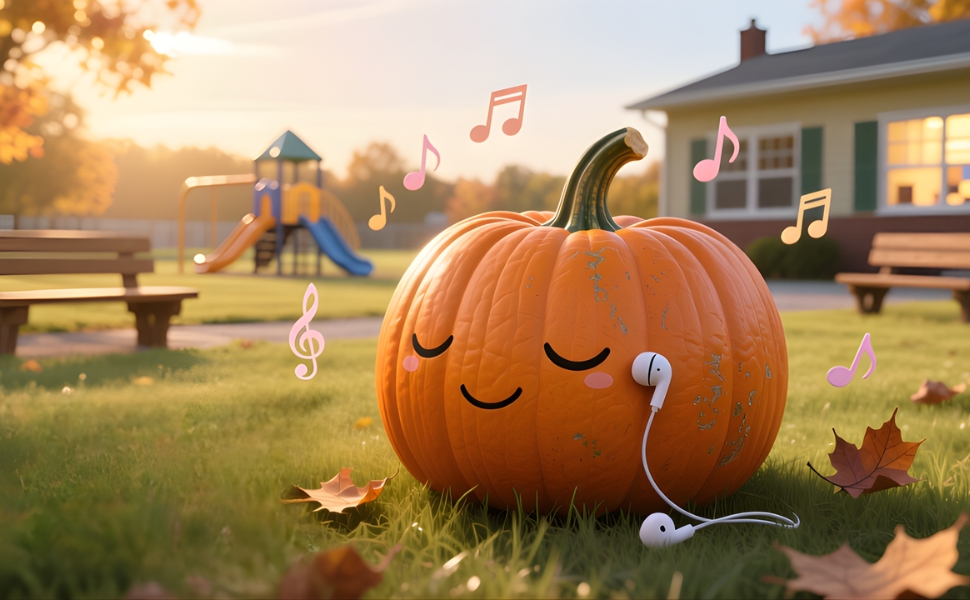
In a quiet garden, there was a small pumpkin named Melody.
Melody was round, orange, and always a little sleepy.
But there was something special about Melody.
She loved music.
Every morning, the birds chirped outside her patch.
Melody listened carefully.
She hummed along softly.
Her gentle hum sounded like a lullaby.
Even the bees stopped to listen.
“Hello, Melody,” said the bees.
“You have a lovely tune.”
Melody smiled and yawned.
She was still a little sleepy.
But music always woke her heart.
One sunny morning, children came to visit the garden.
They were curious about the pumpkins.
“Look at that one!” a little girl said.
“Why is it humming?”
Melody smiled as the children approached.
She tried to hum louder, but she was still drowsy.
The children giggled.
“It’s a sleepy pumpkin!” one boy said.
Melody loved their laughter.
It made her feel awake inside.
She wanted to share her music with them.
But how could a small pumpkin make a big sound?
Melody thought for a while.
She decided to try something new.
She rolled gently to a small rock.
She tapped it with her stem.
A soft, sweet note rang out.
The children clapped.
“Wow! It’s making music!” they shouted.
Melody felt proud.
She tapped again.
She rolled across the garden.
She tapped leaves, stones, and even sticks.
Every sound made a lovely tune.
The children joined in.
They clapped, stomped, and even sang along.
Melody’s sleepy hum turned into a joyful melody.
Even the birds and bees joined the fun.
The garden became a music festival.
Melody tapped gently, creating soft rhythms.
The children danced.
The wind carried the tunes across the fields.
Animals peeked from the trees.
“Music!” they chirped and cheered.
Melody realized music was more fun when shared.
Even when she was sleepy, music could bring happiness.
Later, a gentle breeze blew across the garden.
Melody’s leaves swayed to the rhythm.
Her stem tapped softly on the ground.
She created a calming tune.
The children lay down on the grass, listening.
Some closed their eyes.
Some swayed gently.
Everyone felt peaceful.
Melody loved this feeling.
She loved that her music could make others happy.
She even made new friends that day.
A ladybug named Dot joined in.
She tapped tiny wings to the rhythm.
A rabbit named Thumper bounced along.
He thumped the ground in time.
Even the wind seemed to dance with Melody’s tunes.
As the sun began to set, Melody felt tired again.
She rolled back to her patch.
She yawned a big pumpkin yawn.
The children sat quietly.
They didn’t want the music to end.
But Melody had one more surprise.
She rolled to a small pond.
She tapped the water gently with her stem.
Soft ripples carried the sound.
The reflection in the pond shimmered to the tune.
It was magical.
The children clapped once more.
“Goodnight, Melody,” they whispered.
Melody smiled and closed her eyes.
Her hum turned into a gentle lullaby.
The garden felt calm and peaceful.
All the animals settled down.
Even the wind whispered softly.
Melody dreamed about music.
She dreamed about the children dancing.
She dreamed about tapping on rocks, leaves, and sticks.
She dreamed about making the birds and bees sing along.
When morning came, Melody woke up slowly.
She was still sleepy but happy.
The children returned to the garden.
They brought little instruments.
Tiny drums, shakers, and sticks.
They wanted to play with Melody again.
Melody rolled happily.
She tapped the instruments gently.
The garden became alive with sound.
Everyone played together.
Even the flowers seemed to sway with the music.
Melody learned something important.
Music was not just for listening.
It was for sharing.
It was for creating joy together.
It was for bringing friends closer.
The children learned too.
They learned patience, listening, and harmony.
They learned how to cooperate to create something beautiful.
Each day, Melody’s garden became more musical.
Children from nearby towns came to see the sleepy pumpkin who loved music.
They played, laughed, and tapped along.
Even adults stopped by to enjoy the tunes.
Melody felt proud and happy.
She realized that even a small pumpkin could make a big difference.
Every tap, hum, and ripple mattered.
The garden became famous.
It was called “Melody’s Music Patch.”
Every day, music floated in the air.
Melody loved the attention but even more, she loved the smiles.
She loved seeing children dance and laugh.
She loved the gentle rhythm of happy hearts.
Seasons changed.
Autumn arrived, and new pumpkins grew.
Melody shared her knowledge with them.
She tapped gently and hummed softly.
The new pumpkins learned how to make music.
Soon, the garden was filled with little pumpkin tunes.
Even on windy days, the melodies danced across the fields.
Melody had created something magical.
She had turned a sleepy pumpkin into a source of joy.
And she had taught others to share their talents.
Every night, Melody rested happily.
She remembered the laughter, the dancing, and the music.
She dreamed of new tunes.
She dreamed of new adventures with the children.
She dreamed of making the world a little happier with her pumpkin songs.
Even when she was sleepy, Melody hummed softly.
Her gentle lullaby carried through the garden.
The stars twinkled above.
The moon smiled down.
Melody knew her music had magic.
It could make people dance.
It could make people smile.
It could bring friends together.
And that was the best music of all.
As the seasons passed, Melody continued to play.
Children returned every year.
They brought new instruments.
They sang new songs.
They discovered new ways to make music with pumpkins.
Melody felt proud.
She knew that her love of music could inspire anyone.
Even a sleepy pumpkin can create something wonderful.
Even a small pumpkin can make a big difference.
And every time the garden echoed with laughter and song, Melody’s heart glowed with happiness.
The sleepy pumpkin who loved music had become a symbol of creativity, joy, and friendship.
She taught everyone that music is for everyone.
It is for children, for pumpkins, for birds, bees, and even the wind.
And Melody, the little sleepy pumpkin, would always remind everyone:
Music is magical, and sharing it makes it even better.
3. Pumpkin Detective and the Missing Seeds
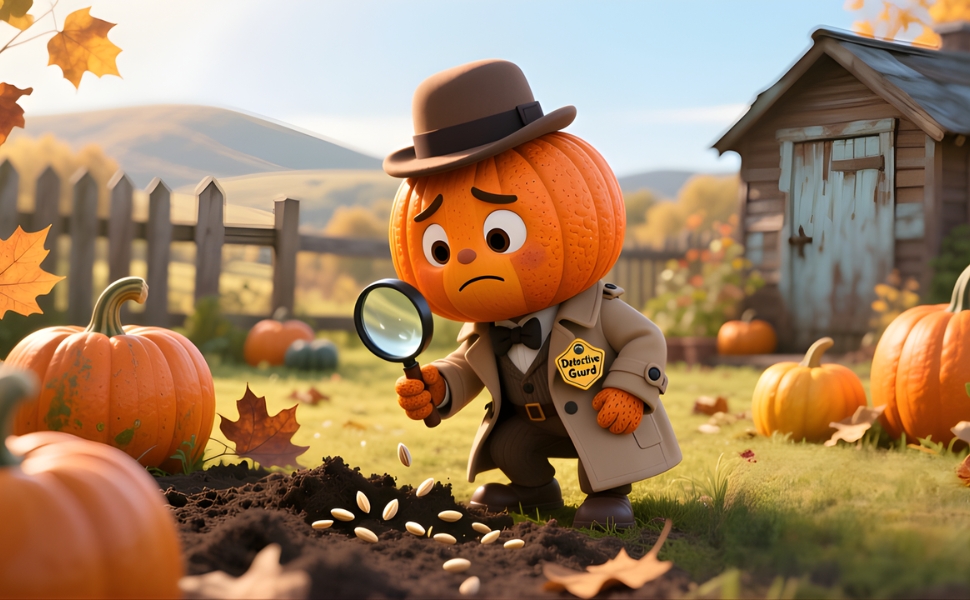
In a quiet garden, there was a small pumpkin named Percy.
Percy was round, plump, and orange.
But Percy had a secret.
He was not just a pumpkin.
He was a detective.
Percy loved solving mysteries.
He wore a tiny detective hat.
He even had a small magnifying glass made from a leaf.
One sunny morning, Percy noticed something unusual.
Some seeds were missing from the pumpkin patch.
“Hmm,” Percy said, squinting.
“This is a mystery!”
He rolled carefully among the pumpkins.
He inspected each one.
Some had seeds on the surface.
Others were empty.
Percy furrowed his stem.
Who could have taken the seeds?
He called the other pumpkins together.
“Has anyone seen anything strange?” Percy asked.
“I saw a shadow last night,” said Polly Pumpkin.
“It moved quickly across the patch.”
Percy nodded.
“That’s a good clue,” he said.
He decided to investigate at night.
That evening, the moon shone brightly.
The garden was quiet.
Percy rolled slowly, looking for footprints or signs.
He spotted tiny marks in the soil.
“They’re too small for a human,” Percy said.
“Maybe it’s an animal.”
Percy followed the trail.
It led him to the edge of the garden.
There, he saw a group of squirrels.
They were busy carrying pumpkin seeds to their tree.
“Ah-ha!” Percy exclaimed.
“The squirrels are the culprits!”
But he didn’t want to be angry.
Percy knew the squirrels were just hungry.
He decided to approach them carefully.
“Hello, squirrels,” he said gently.
The squirrels froze.
Percy continued, “I know you took the seeds, but let’s find a solution.”
The squirrels chattered nervously.
Percy had an idea.
“We can share the seeds,” he said.
“I’ll gather some extra seeds for you every day.”
The squirrels’ eyes lit up.
They nodded eagerly.
Percy smiled.
He had solved the mystery.
But he had also created a new friendship.
The next day, Percy rolled to the pumpkin patch.
He told the other pumpkins about his plan.
“We’ll share with the squirrels,” he said.
“They’ll be happy, and we’ll still have plenty of seeds.”
The pumpkins agreed.
They felt proud of Percy’s clever thinking.
Percy organized a seed-sharing station.
Each day, the squirrels received seeds without taking from the patch.
They even helped Percy plant new seeds.
The pumpkin patch grew bigger and healthier than ever.
Percy felt proud of his detective work.
He had solved a mystery and helped everyone.
But Percy didn’t stop there.
He became the official Pumpkin Detective of the garden.
Whenever something strange happened, Percy was ready.
One morning, he noticed footprints leading to the compost pile.
He followed them and found a group of rabbits nibbling on leftover pumpkin vines.
“Hello, rabbits,” Percy said.
“Would you like to help plant new pumpkins?”
The rabbits nodded.
Together, they planted seeds and watered the garden.
The garden became a place of teamwork and friendship.
Percy realized mysteries could be solved without anger.
He also learned that helping others often leads to unexpected joy.
Children from nearby farms visited Percy’s garden.
They loved watching him investigate.
They brought magnifying glasses and pretended to be detectives too.
Percy taught them how to look for clues carefully.
He showed them how to solve problems with kindness.
Even the birds joined in.
They would watch the squirrels and alert Percy to any unusual activity.
Percy became a hero in the garden.
He inspired everyone to think, observe, and care.
Every morning, he checked the patch.
Every evening, he shared seeds with the squirrels.
He even made a notebook to record every clue and solution.
Percy’s detective work made the pumpkin patch famous.
Nearby gardens sent visitors to learn from him.
Percy welcomed them all.
He loved teaching children about observation, patience, and teamwork.
The squirrels and rabbits became his assistants.
They helped with planting, watering, and guarding the patch.
The garden was full of life and happiness.
Percy realized that mysteries are not just problems.
They are opportunities to help, learn, and grow.
He also discovered that sharing and kindness make solutions even better.
One autumn afternoon, a new mystery appeared.
Some pumpkin vines were tangled and broken.
Percy rolled over to investigate.
He noticed tiny tracks leading to a burrow.
Inside, he found a family of hedgehogs.
“They are just trying to make a home,” Percy thought.
He explained to the hedgehogs that the garden had rules.
He offered them a soft corner of the patch to live in.
The hedgehogs were happy.
They promised to be careful and not damage the pumpkins.
Percy smiled.
Once again, he solved a mystery with kindness.
The garden was peaceful.
Every pumpkin was safe.
Every animal was happy.
And Percy’s detective hat sat proudly on his stem.
He had learned that being a detective is not only about finding clues.
It is about helping, understanding, and caring for everyone.
Percy continued his work every day.
He found missing seeds, curious animals, and tiny surprises.
The children learned to help him.
They recorded clues in their notebooks.
They shared seeds with animals and kept the garden tidy.
Percy felt proud.
He knew that small actions create big results.
The pumpkin patch thrived.
The pumpkins grew larger.
The garden was full of laughter and joy.
Percy realized that mysteries bring excitement.
But solving them with kindness brings happiness.
Every evening, he rested under the moonlight.
He dreamed of new adventures.
He dreamed of new friends and new mysteries to solve.
He dreamed of a garden where everyone worked together.
The next day, Percy rolled through the patch once more.
He checked every pumpkin and every seed.
He made notes in his detective notebook.
He smiled at the squirrels, rabbits, and hedgehogs.
He nodded at the children learning from him.
Everything was in harmony.
Percy knew that the garden was not just a patch of pumpkins.
It was a place of friendship, learning, and care.
And Percy, the Pumpkin Detective, had made it that way.
The garden became a place where pumpkins, animals, and children lived together happily.
Percy’s story spread to nearby towns.
Children came with notebooks, magnifying glasses, and curiosity.
They learned to solve mysteries and help others.
They learned that kindness can solve more than cleverness alone.
Percy’s legend grew.
And the pumpkin patch became a magical place where adventures and mysteries awaited every day.
Even when the seasons changed, and the pumpkins were harvested, Percy continued his work.
New pumpkins grew every year.
New animals came to the garden.
New children visited.
Percy welcomed them all.
He taught them everything he had learned.
He taught them to observe carefully.
He taught them to share.
He taught them that even small pumpkins can make a big difference.
And so, the Pumpkin Detective kept solving mysteries.
He helped animals, guided children, and made the pumpkin patch a wonderful place.
Percy learned that being a detective is about curiosity, care, and courage.
He knew that mysteries are adventures waiting to happen.
And Percy, the clever pumpkin, smiled every day under the sun.
He had found his purpose: to protect, teach, and bring joy to everyone in the garden.
4. The Rainbow Pumpkin
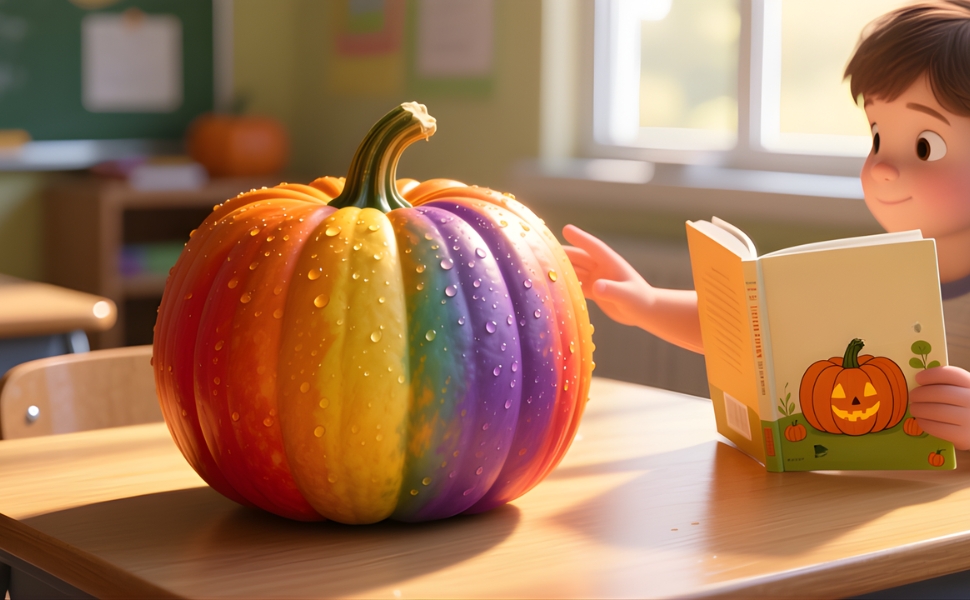
In a quiet garden, a tiny pumpkin patch grew.
All the pumpkins were round and orange.
Well… almost all of them.
One pumpkin was different.
It had stripes of every color: red, blue, yellow, green, and purple.
Its name was Ray.
Ray was the Rainbow Pumpkin.
He loved his colors.
But the other pumpkins didn’t understand him.
“You’re too bright!” they said.
“You don’t look like a real pumpkin!”
Ray felt a little sad.
He wished they would see how special he was.
One morning, a little girl named Emma came to the garden.
She loved pumpkins and bright colors.
When she saw Ray, her eyes lit up.
“Wow! Look at you!” she said.
Ray felt happy for the first time.
Emma gently picked him up.
She noticed every stripe and shimmer.
“You’re beautiful,” she whispered.
Ray beamed.
He realized that someone appreciated him.
That afternoon, Emma brought her friends to the garden.
They saw the rainbow pumpkin and gasped in delight.
“Can we paint pumpkins like that?” one asked.
Ray shook with excitement.
He wasn’t just a pumpkin; he was an inspiration.
The other pumpkins watched carefully.
They began to see that Ray’s colors made the patch brighter.
It made the garden more fun.
Ray rolled proudly between the other pumpkins.
He realized being different could be wonderful.
That night, a soft wind blew through the garden.
The moonlight shone on Ray.
His colors glowed softly.
He felt magical.
Birds and fireflies gathered near him.
They danced in the glowing light.
The garden seemed alive.
Ray had brought joy and wonder to everyone.
The next day, a group of children came with paintbrushes.
They wanted to try creating “rainbow pumpkins” like Ray.
Ray rolled gently to show them the colors.
Emma helped the children dip their brushes carefully.
Soon, the garden was filled with pumpkins painted with stripes and dots.
It looked like a rainbow had fallen into the patch.
Ray was happy.
He had inspired creativity.
But the garden still had some challenges.
Some pumpkins felt left out.
They worried they weren’t special.
Ray had an idea.
He rolled among them and said, “Everyone is unique in their own way.
You don’t need to be rainbow-colored to shine.”
The pumpkins listened carefully.
They began to appreciate their own shapes and colors.
The garden became a place of acceptance.
Every pumpkin was celebrated for being itself.
Even the birds, bees, and butterflies noticed.
They danced and hummed happily.
Ray felt proud.
He had helped everyone see the beauty in differences.
One windy day, Emma tied a small ribbon around Ray.
It fluttered in the wind like a tiny flag.
Ray rolled gently across the patch.
Children laughed and cheered.
He felt proud and loved.
Soon, a local school teacher brought her class to visit the rainbow pumpkin.
The children learned about colors, diversity, and creativity.
Ray became a lesson in kindness and acceptance.
He showed that being different can inspire others.
Every day, children visited, rolled him gently, and admired his colors.
The other pumpkins joined in, feeling happy to be part of a magical garden.
Seasons changed, and autumn arrived.
The leaves turned gold and red.
The garden was full of pumpkins, both orange and colorful.
Ray’s colors glowed brighter against the autumn backdrop.
One morning, a storm came.
The wind blew strongly, and leaves swirled everywhere.
Ray rolled carefully to protect the smaller pumpkins.
He stayed close to them until the storm passed.
After the storm, the garden looked even more beautiful.
Ray realized that being brave was as important as being colorful.
He had learned lessons about friendship, courage, and creativity.
The next day, Emma and her friends returned.
They brought ribbons, paints, and brushes.
The garden became a festival of colors.
Everyone laughed, painted, and celebrated.
Ray felt joy in his heart.
He realized that his differences had made a positive difference in the world.
Even the other pumpkins began to roll closer.
They learned that it was okay to stand out.
It was okay to be unique.
Ray taught them that everyone shines in their own way.
The children planted more seeds in the garden.
They imagined what the next rainbow pumpkin might look like.
Ray rolled happily, knowing he had inspired creativity and acceptance.
The birds sang cheerful tunes.
The bees buzzed softly.
Even the wind seemed to whisper encouragement.
The garden became a magical place where pumpkins, children, and animals celebrated uniqueness every day.
One evening, Emma whispered to Ray, “Thank you for teaching us to be ourselves.”
Ray glowed softly in response.
He felt proud, happy, and loved.
He realized that colors, courage, and kindness could change the world, even in a small garden.
The rainbow pumpkin became famous far and wide.
Children from other towns visited to see him and learn his lessons.
Ray welcomed everyone with a gentle glow.
He knew that sharing joy and creativity made life brighter.
Seasons came and went, but Ray remained colorful and inspiring.
New pumpkins grew beside him.
New children discovered the garden.
Every day, Ray rolled gently among the patch, spreading happiness and acceptance.
He had discovered that being different was not just special—it was magical.
Even when the autumn leaves fell, Ray’s colors shone.
He reminded everyone that uniqueness is a gift.
That night, under a sky full of stars, Ray whispered softly to the garden:
“Be proud of who you are, and shine bright in your own way.”
The garden hummed softly in agreement.
Every pumpkin, child, bird, and butterfly felt the magic of Ray’s lesson.
The rainbow pumpkin had taught them all something important:
Different is beautiful.
Different is wonderful.
And a small pumpkin with courage and color can change the world.
Ray rolled to the center of the patch.
He glowed softly, ready for the next day’s adventure.
He knew that every child who visited would carry his lesson in their heart.
And Ray, the Rainbow Pumpkin, would always shine brightly, teaching creativity, courage, and kindness to everyone who came to the magical garden.
5. Pumpkin Cloud Adventure
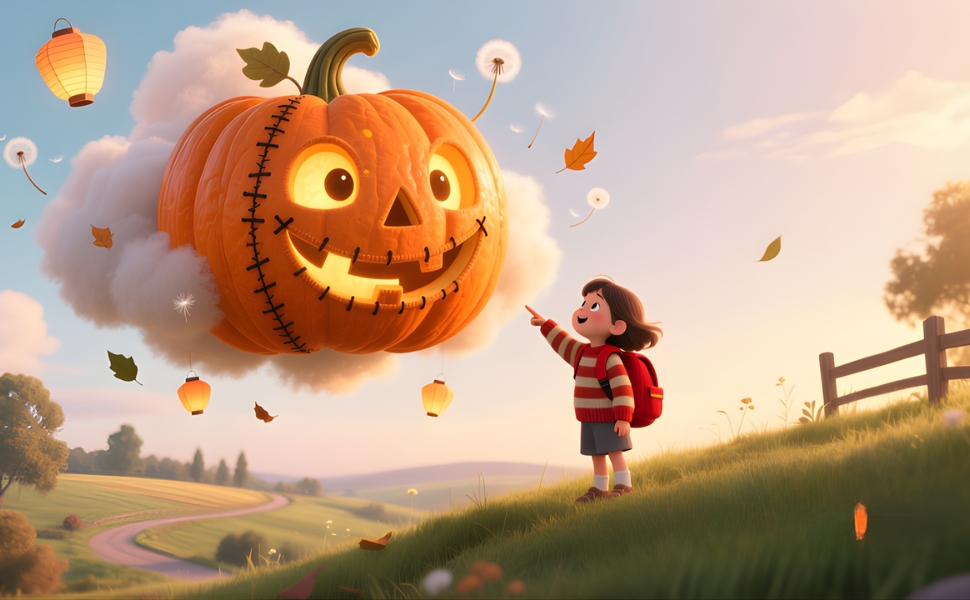
In a bright, sunny garden, there lived a curious pumpkin named Puffy.
Puffy was round, orange, and loved exploring.
He was different from the other pumpkins.
While they stayed in one spot, Puffy dreamed of adventures.
“I want to see the world!” he whispered one morning.
The other pumpkins laughed.
“You’re just a pumpkin. You can’t move far!” they said.
But Puffy was determined.
One windy afternoon, Puffy rolled down a gentle hill.
He giggled as he bounced along the grass.
The wind was strong that day.
Suddenly, a fluffy white cloud floated close to the hill.
It swirled and twirled in the sky.
Puffy watched in awe.
The cloud looked soft and magical.
“I wonder if I can ride it,” Puffy thought.
He rolled closer.
The cloud dipped low.
Puffy jumped carefully onto it.
To his surprise, the cloud held him!
He bounced gently as it lifted into the sky.
“Wow! I’m flying!” Puffy shouted.
The garden below looked tiny.
The trees were little green dots.
The flowers were bright specks of color.
Puffy felt the wind on his skin.
It tickled and cooled him.
He spun slowly on the cloud.
The birds flew beside him.
“Hello, Puffy!” they chirped.
Even the butterflies joined in, twirling around the cloud.
Puffy felt like he was in a dream.
The cloud carried him over hills and valleys.
He saw rivers that sparkled like silver.
He saw forests filled with dancing leaves.
He saw mountains with snow on top.
Everything looked magical from above.
Puffy realized how big the world was.
He also realized how lucky he was to fly.
The cloud swirled higher, taking Puffy even closer to the sun.
He could see the horizon stretching endlessly.
The wind whistled a happy tune.
Puffy rolled gently, following the rhythm.
He discovered he could bounce and twirl on the cloud.
It felt like riding a soft trampoline in the sky.
Suddenly, Puffy spotted something below.
A little bird had dropped a shiny feather.
Puffy carefully leaned over the edge of the cloud.
He grabbed the feather with his stem.
“I should return this,” Puffy said.
The cloud swooped down gently.
The little bird chirped joyfully.
“Thank you, Puffy!” it sang.
Puffy smiled.
He realized that adventures were better when you helped others.
The cloud carried him over a village.
Children played in the fields, waving at Puffy.
“Look! A flying pumpkin!” they shouted.
Puffy waved back.
He felt proud to bring joy to others.
The cloud swirled toward a lake.
Its surface sparkled like glass.
Puffy leaned down and tapped it gently.
Ripples spread across the water.
The reflection of the sky and Puffy danced together.
It was magical.
Puffy laughed with delight.
The cloud lifted him higher, showing a rainbow forming after a brief shower.
The colors stretched across the sky like a bridge.
Puffy bounced carefully along the cloud, following the rainbow.
It was the most beautiful thing he had ever seen.
He felt happy, excited, and free all at once.
After some time, the cloud floated over a forest.
Puffy saw animals below: deer, rabbits, and squirrels.
They looked up and waved their paws and tails.
The birds flew around Puffy, singing cheerful songs.
The wind carried their melodies across the sky.
Puffy felt like part of a big, magical orchestra.
He realized adventures are not just about seeing new places.
They are about noticing beauty, helping others, and feeling joy.
As the sun began to set, the cloud drifted gently back toward the garden.
Puffy saw the familiar pumpkin patch below.
He felt a little sad that the adventure was ending.
But he was also happy.
He had flown on a cloud.
He had helped a bird.
He had seen rainbows, rivers, and mountains.
He had shared joy with children and animals.
The cloud landed softly in the garden.
Puffy rolled off carefully.
He looked up and whispered, “Thank you for the adventure.”
The cloud swirled one last time and floated away.
Puffy realized something important.
Adventure isn’t just about traveling.
Adventure is about exploring, helping, and learning.
Every small action can bring happiness.
The next morning, Puffy shared his story with the other pumpkins.
“They laughed at me,” he said.
“But I flew on a cloud!”
The pumpkins listened in amazement.
They realized that dreams can come true, even for small pumpkins.
Puffy smiled proudly.
He knew that courage and curiosity could take him anywhere.
Days passed, and children returned to the garden.
Puffy showed them the hill where he started his cloud adventure.
He told them about the rivers, mountains, rainbow, and bird.
They listened eagerly and imagined flying alongside him.
Puffy realized he had inspired them.
He had shown that even a pumpkin can have incredible adventures.
Animals in the garden also gathered around.
They listened to Puffy’s stories of clouds, wind, and sky.
They felt inspired to explore more safely and carefully.
Puffy rolled gently among the patch.
He shared wisdom about courage, kindness, and curiosity.
He even created small games to teach children about observing nature.
The garden became a place of imagination and adventure.
Each pumpkin, bird, and animal learned from Puffy.
They discovered that flying on a cloud might not be possible every day.
But dreaming, imagining, and helping others was always possible.
Puffy felt proud of his adventure.
He realized the magic of curiosity, courage, and joy.
Every sunset, Puffy rolled to the hilltop.
He imagined the clouds waiting for him.
He dreamed of flying again.
Even when the seasons changed, Puffy remembered the thrill.
He remembered the wind, the rainbow, and the happy children.
Puffy became a legend in the pumpkin patch.
Children from nearby towns visited to hear his cloud adventure.
They imagined flying with him and helping animals along the way.
Every time a cloud floated low, Puffy bounced with excitement.
He knew that new adventures awaited.
Puffy’s story taught the pumpkins and children alike:
Adventures are everywhere, even in your own garden.
Curiosity and courage make even ordinary pumpkins extraordinary.
Helping others makes adventures magical.
And the sky is not the limit—your imagination is.
Puffy rolled back to the patch as the stars appeared.
He rested, dreaming of clouds, rainbows, and new friends.
He whispered softly, “Tomorrow, I will fly again.”
The garden hummed quietly in agreement.
And Puffy, the brave pumpkin, knew that every day could bring a new adventure.
6. Pumpkin and the Friendly Scarecrow
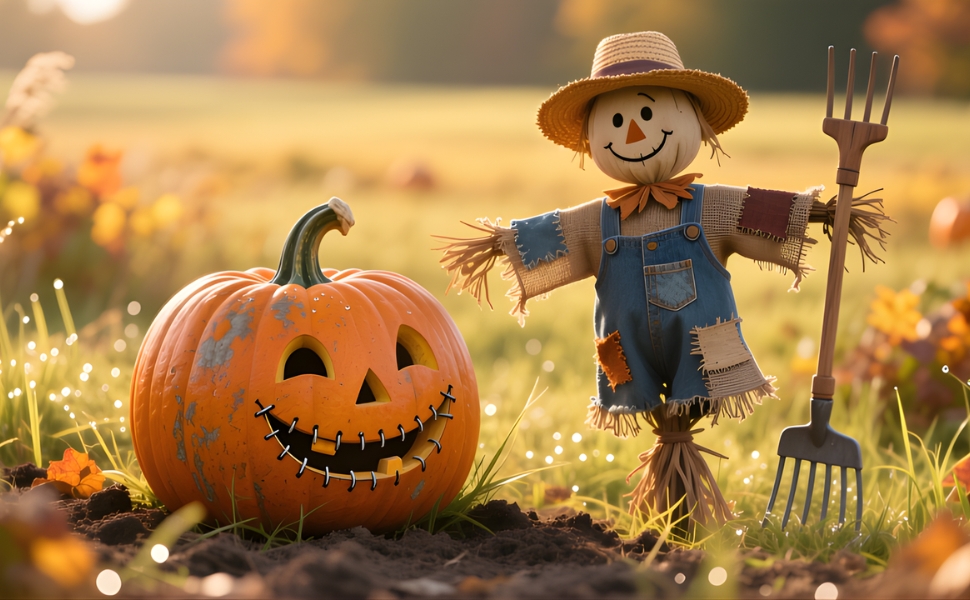
In a cozy pumpkin patch, there was a cheerful pumpkin named Pippa.
Pippa was round, bright orange, and loved making friends.
Every morning, the sun shone warmly on the garden.
Pippa greeted the birds, bees, and butterflies.
But there was one friend she hadn’t met yet: the scarecrow.
The scarecrow stood tall at the edge of the patch.
He wore a straw hat, a checkered shirt, and a gentle smile.
Pippa had always been curious about him.
“Does he like pumpkins?” she wondered.
“Will he be my friend?”
One windy morning, Pippa rolled closer to the scarecrow.
“Hello!” she called softly.
The scarecrow didn’t move.
He tilted his head slightly, and his straw hat wobbled.
Pippa felt a little shy.
“Hi, my name is Pippa,” she said.
The scarecrow didn’t answer.
But his smile seemed friendly.
Pippa decided to visit him every day.
Each morning, she rolled near the scarecrow.
She told him stories about the pumpkin patch.
She shared news about the birds and the bees.
Slowly, Pippa noticed that the scarecrow seemed to listen.
His head tilted differently each day.
Sometimes, his arms swayed with the wind as if waving at her.
Pippa felt happy.
She had made a friend, even if he couldn’t talk.
One afternoon, the sky turned dark.
The wind blew stronger than ever before.
Leaves, sticks, and dust swirled across the pumpkin patch.
Pippa rolled close to the scarecrow for protection.
Suddenly, a gust of wind knocked the scarecrow over!
“Oh no!” Pippa cried.
She tried to roll him back upright.
It was heavy, but Pippa didn’t give up.
She pushed with all her strength.
Finally, the scarecrow stood tall again.
Pippa panted but felt proud.
“You’re safe now,” she whispered.
The scarecrow’s smile seemed brighter than ever.
That evening, the garden was peaceful.
Pippa realized how important friends are.
Even a scarecrow could be a true friend.
The next morning, Pippa wanted to do something nice.
She gathered flowers from the garden.
She placed them gently at the scarecrow’s feet.
The flowers were bright and colorful.
The scarecrow seemed to “nod” in gratitude.
Pippa felt happy.
Friendship, she learned, is about caring.
Days went by, and Pippa shared more stories.
She told the scarecrow about her dreams of growing big and round.
She told him about her favorite birds and butterflies.
The scarecrow “listened” patiently.
One day, a family of birds built a nest in the scarecrow’s hat.
Pippa was excited.
“Look! Your hat is a home now!” she giggled.
The scarecrow stayed still, letting the birds settle.
Pippa realized that being a good friend sometimes means giving space.
Autumn arrived, and the garden was full of pumpkins.
Pippa and the scarecrow spent every day together.
They watched children visit the patch.
The children laughed, rolled pumpkins, and picked bright gourds.
Pippa shared stories about the scarecrow.
“They’re friendly,” she told them.
The scarecrow seemed to smile even more.
One chilly morning, Pippa noticed that the scarecrow’s scarf was loose.
The wind could blow it away.
She carefully adjusted it.
“Now you’re cozy,” she said.
The scarecrow “looked” grateful.
Friendship, Pippa realized, is also about small acts of kindness.
As Halloween approached, the garden became even more lively.
Children came to carve pumpkins.
Pippa rolled with excitement.
The scarecrow stood tall, watching over everyone.
He didn’t scare anyone.
He was friendly and gentle.
Pippa wanted to thank him.
She rolled a tiny pumpkin to his feet as a gift.
The scarecrow’s hat wobbled slightly, as if saying “thank you.”
Pippa laughed.
She realized that friendship can exist even without words.
The garden was full of warmth and happiness.
Animals, children, pumpkins, and even the scarecrow shared joy together.
One night, the wind whispered through the pumpkin patch.
Pippa rolled close to the scarecrow.
“I’m glad we’re friends,” she said softly.
The scarecrow’s straw arms swayed gently in the breeze.
It felt like he was nodding in agreement.
The next morning, Pippa and the scarecrow watched the sunrise.
The sky turned orange, pink, and purple.
The garden sparkled in the morning light.
Pippa rolled to the scarecrow’s side.
“Today is another day for adventures,” she whispered.
The scarecrow “stood” proudly beside her.
Together, they watched birds, butterflies, and children play.
They shared the quiet moments of the garden.
Pippa realized that friendship doesn’t need words.
It’s about care, presence, and shared experiences.
As the weeks passed, Pippa taught the scarecrow about games.
They rolled pumpkins together.
They counted seeds.
They watched clouds and guessed their shapes.
The scarecrow remained patient and kind.
Even when Pippa wobbled too far, he seemed to support her.
The other pumpkins noticed their friendship.
They began to roll closer to the scarecrow too.
They learned that he was gentle and friendly.
The garden became more lively.
Everyone felt safe and happy.
One evening, a gentle rain began.
Pippa rolled under a leaf, but the scarecrow stayed tall, protecting the pumpkins.
He shielded them from the drops.
Pippa realized the scarecrow’s role was not only to watch over the garden but to care.
Friendship, she thought, is about supporting each other through challenges.
The rain stopped, and a rainbow appeared.
Pippa and the scarecrow watched it together.
It stretched across the garden like a colorful bridge.
Pippa smiled.
She knew that every day with her friendly scarecrow was special.
She had learned lessons about patience, care, and friendship.
Even without words, the scarecrow taught her about kindness.
Children visiting the patch noticed the bond too.
They laughed and played around them.
Pippa rolled happily among them.
She realized that sharing joy with friends makes life brighter.
As Halloween came, the children carved pumpkins in the patch.
They placed small hats and scarves on their pumpkins.
Pippa rolled proudly beside her scarecrow friend.
The garden glowed with orange light from jack-o’-lanterns.
The scarecrow watched over the festivities.
He didn’t need to say anything.
Everyone knew he was a good friend.
Pippa realized that even a quiet friend can make a big difference.
The garden became a place of laughter, care, and friendship.
Every pumpkin, bird, child, and butterfly felt safe and happy.
Pippa rolled next to the scarecrow every day.
She told him about her dreams and adventures.
She listened to the soft sounds of the garden.
The scarecrow remained calm, supportive, and friendly.
He showed that friends can be gentle, caring, and always there for you.
Even when winter approached and snow began to fall, Pippa rolled close to the scarecrow.
They watched the first snowflakes together.
Pippa realized that friendship lasts through all seasons.
It doesn’t matter if someone talks or stays still.
It matters that they care, protect, and share joy.
The garden became famous in the town.
Children visited to see the friendly scarecrow and the cheerful pumpkin.
They learned about friendship, kindness, and caring.
Pippa felt proud of her garden, her scarecrow, and the bonds they shared.
The scarecrow had taught her lessons about patience and support.
Pippa had taught him about joy and companionship.
Together, they made the garden a magical place.
Every day, the pumpkin patch buzzed with life.
Every sunset, Pippa rolled to the scarecrow’s side.
She whispered softly, “Thank you for being my friend.”
The scarecrow’s straw hat tilted gently.
It felt like a nod of happiness.
And in the quiet of the night, under the twinkling stars, Pippa and the friendly scarecrow shared a simple truth:
Friendship is about caring, supporting, and being together.
It doesn’t need words.
It only needs heart.
7. The Pumpkin That Could Paint
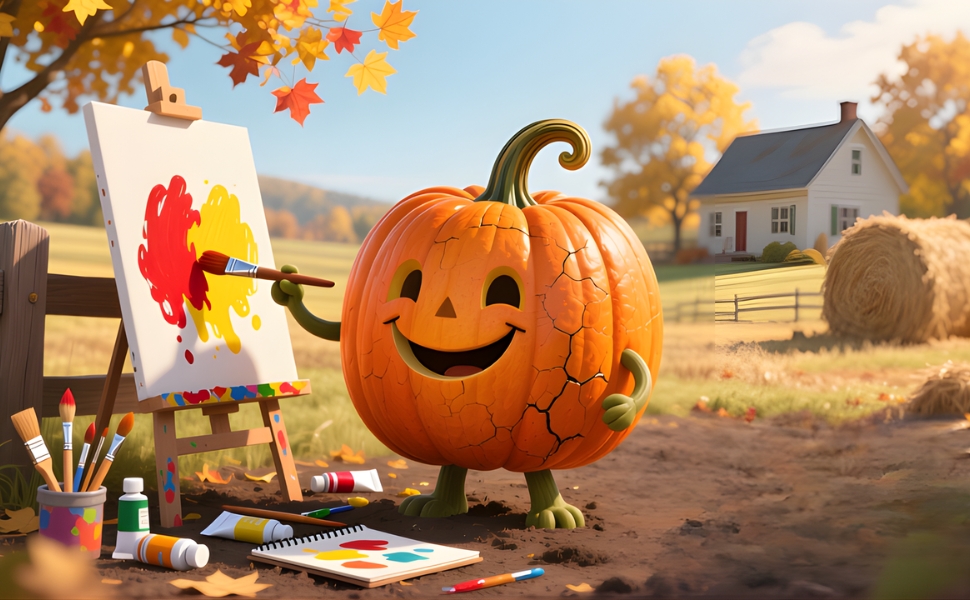
In a cozy little garden, there was a pumpkin named Pablo.
Pablo was not like the other pumpkins.
He loved colors.
He loved brushes.
And he loved to paint.
Every morning, Pablo would watch the sunlight fall on the garden.
He noticed the colors of flowers, leaves, and the sky.
He wished he could capture them.
One morning, Pablo decided to try.
He rolled over to the shed where Farmer Lily kept paint and brushes.
He picked up a tiny brush with his stem.
It was tricky at first.
He dipped it in bright red paint.
He pressed it carefully onto a leaf.
“Wow!” Pablo whispered.
The leaf looked like it was glowing.
Encouraged, he tried again.
Blue, yellow, green, purple—Pablo mixed colors and shapes.
Soon, the garden had tiny painted leaves scattered everywhere.
The other pumpkins watched curiously.
“What is he doing?” asked one.
“He’s just a pumpkin. Can he paint?” said another.
Pablo didn’t mind.
He kept painting, rolling from leaf to leaf, stem to brush.
By noon, he had painted a whole corner of the garden.
The colors shimmered in the sunlight.
A butterfly landed on a painted leaf.
It seemed to dance with joy.
Pablo laughed softly.
Painting made him happy.
The next day, he tried bigger projects.
He rolled near the garden fence.
He dipped his brush in orange and yellow.
He painted a sunrise on a blank wooden board.
The other pumpkins gasped.
“It looks like the real sun!” they exclaimed.
Pablo felt proud.
He realized that he could share beauty with others.
Farmer Lily noticed the colorful garden.
She smiled.
“This is amazing!” she said.
She called her grandchildren to see.
The children laughed and clapped.
They watched Pablo paint with his tiny brush.
“Look at that pumpkin go!” they cheered.
Pablo rolled carefully, dipping his brush in new colors.
He painted flowers, clouds, and even little animals.
The garden was alive with colors.
Birds flew closer to see the artwork.
Even the bees hovered over bright flowers.
Everyone seemed happier in the colorful garden.
Pablo realized something important.
His painting could bring joy to others.
Every stroke, every color mattered.
He decided to create a special painting for the harvest festival.
He wanted it to be big and bright.
He rolled carefully to the barn.
He set up brushes, paints, and blank boards.
For days, Pablo painted tirelessly.
Red pumpkins, orange leaves, golden sunbeams, and green vines appeared on the board.
Children visited every morning to watch him paint.
They cheered and learned about colors.
“Can we try?” one asked.
Pablo shared a small brush.
Together, they added tiny stars and dots.
It became a collaborative artwork.
The garden looked magical.
Even the other pumpkins felt inspired.
Some tried to paint leaves with stems.
Some rolled gently across boards, creating new patterns.
Everyone learned that creativity comes in many forms.
The harvest festival arrived.
People from nearby villages came to see the pumpkin patch.
When they saw Pablo’s painting, they gasped.
Bright, cheerful, full of life—it was unlike anything they had seen.
Pablo rolled proudly, his colors blending with the autumn leaves.
Children clapped and adults smiled.
Farmer Lily placed a ribbon beside Pablo’s painting.
“You’re the star of the festival,” she said.
Pablo glowed with happiness.
He had never felt so proud.
The festival continued with music, games, and laughter.
People shared stories, pumpkins, and delicious treats.
But everyone kept coming back to see Pablo’s artwork.
They admired the colors, the patterns, and the joy it brought.
Pablo realized that sharing his passion had made the world brighter.
After the festival, Pablo continued to paint.
Every day, he found new ideas.
He painted clouds, rivers, butterflies, and flowers.
Sometimes he painted imaginary creatures.
Sometimes he painted scenes from his dreams.
The garden was filled with Pablo’s creativity.
Animals and pumpkins gathered around.
They watched the colors shimmer in the sunlight.
Children visited often.
They wanted to paint with Pablo.
He shared brushes and taught them gently.
“Colors are everywhere,” he said.
“You just have to look closely.”
The children learned to notice details in leaves, petals, and clouds.
They painted tiny pumpkins, flowers, and stars.
Pablo felt proud to inspire them.
He realized painting was not just about himself.
It was about sharing joy and creativity.
One windy afternoon, a big storm came.
Rain poured and the wind blew fiercely.
Pablo’s painted boards were at risk of washing away.
He rolled quickly to cover them with large leaves.
The children helped him, holding the leaves down.
After the storm, the garden looked fresh and shiny.
The colors seemed brighter than ever.
Pablo realized that caring for his art was also part of being a good artist.
Seasons changed, and winter approached.
The garden was quiet, with frost on the leaves.
Pablo didn’t stop painting.
He created winter scenes: snowflakes, bare trees, and sparkling icicles.
Even in the cold, his colors warmed the garden.
Animals gathered around, watching in amazement.
The children returned on weekends to paint alongside him.
Pablo felt happy.
He knew that painting could brighten any season.
One evening, Pablo looked at all his paintings.
He saw the joy he had shared.
He remembered the festival, the children, the animals, and the pumpkins.
He realized that creativity could inspire everyone.
Even the other pumpkins rolled closer, curious and amazed.
They admired his bright colors.
Pablo smiled.
He had learned that sharing his passion was as important as creating it.
Every leaf, board, and stroke of paint brought happiness.
The sun rose the next morning, and Pablo rolled to his favorite spot.
He dipped his brush in new colors.
He painted the sky, the hills, and the garden.
He imagined new stories and adventures.
The children watched and cheered.
Pablo knew he had created something bigger than himself.
He had painted joy, friendship, and inspiration.
The garden had become a magical place.
Every pumpkin, child, and animal felt the magic of colors.
Even the wind seemed to carry the shimmer of his paintings.
Pablo realized that creativity, courage, and sharing could make the world brighter.
Every day, he painted, inspired, and smiled.
He knew that even a small pumpkin could create big wonders.
And in the quiet of the evening, under the soft glow of the sunset, Pablo whispered to the garden:
“Paint, dream, and share. Colors are magic, and magic is everywhere.”
The garden hummed softly in agreement.
Pablo, the pumpkin that could paint, had taught everyone an important lesson:
Imagination, kindness, and creativity can make every day extraordinary.
And every pumpkin, child, and animal carried a little piece of his magic in their hearts.
How to Read Pumpkin Stories for First Graders Aloud
A strong read-aloud sequence helps comprehension. Follow these steps when you read Pumpkin Stories for First Graders.
- Introduce the cover and make one prediction.
- Pre-teach 3 key words (e.g., vine, seed, harvest).
- Read with expression and short pauses.
- Pause for a prediction or quick sketch at turning points.
- Confirm predictions at the end and ask for a one-line retell.
When you practice these steps, students learn to listen for main ideas and sequence.
Sample 45-Minute Lesson Plan Using Pumpkin Stories for First Graders
Objective: Retell a simple story and record seed counts.
Materials: Book, small pumpkin, seed cups, chart paper, pencils.
- Hook (5 min): Show the pumpkin. Ask, “What is inside this pumpkin?”
- Read Aloud (12 min): Read a selected Pumpkin Stories for First Graders title. Pause for 3 predictions.
- Mini-Lesson (8 min): Model counting by tens using seeds. Record on chart paper.
- Activity (15 min): Small groups extract and count seeds, then place tens in cups.
- Share (5 min): One student from each group reports totals.
Assessment: Quick exit ticket — “Write two words about our story today.”
This lesson blends literacy and math in one focused block. Repeat the pattern over multiple days to support retention.
Three-Day Unit Example
Day 1: Story & Sequence
- Read a narrative Pumpkin Stories for First Graders title.
- Focus: plot and character.
- Task: Students draw three major events.
Day 2: Science & Inquiry
- Read a nonfiction picture book about pumpkin growth.
- Focus: life cycle stages.
- Task: Plant pumpkin seeds in clear cups and make daily notes.
Day 3: Math & Celebration
- Measure class pumpkins with string and compare circumferences.
- Focus: estimating and data display.
- Task: Create a bar graph of pumpkin sizes.
This short unit shows how Pumpkin Stories for First Graders create natural, scaffolded learning episodes.
Activities to Extend Pumpkin Stories for First Graders
Practical, classroom-ready activities help students apply knowledge.
Seed Sorting & Grouping
- Count seeds in groups of ten.
- Practice skip-counting by tens.
Life Cycle Wheels
- Small paper plates with four sections: seed, sprout, flower, pumpkin.
Pumpkin Measurement Lab
- Use string to measure circumference.
- Compare estimates vs. actual measures.
Sensory Bin
- Add dried seeds, fabric leaves, and small gourd models.
- Include vocabulary cards for tactile matching.
Recipe Read-Aloud
- Read a simple pumpkin recipe.
- Follow with a teacher-led cooking demo or tasting.
Each activity supports skills in observation, measurement, and language. When you plan Pumpkin Stories for First Graders units, choose activities that align to your standards and available materials.
Differentiation and Scaffolds
Adapt tasks to meet varied learner needs when teaching Pumpkin Stories for First Graders.
- Emergent readers: Use repeated phrases and picture-supported sentence frames. Provide partner reading.
- English learners: Pre-teach key vocabulary and provide visuals. Use gestures and real objects.
- Advanced learners: Offer extension tasks like designing an experiment on light vs. shade or writing a short informational paragraph.
- Students with sensory needs: Provide a calm corner, noise-cancelling options, and alternative sensory tools.
These supports make Pumpkin Stories for First Graders accessible and inclusive.
Assessment Strategies
Use quick formative checks tied to Pumpkin Stories for First Graders concepts.
- Observation Checklist: Participation, turn-taking, and ability to retell.
- Exit Ticket: One-sentence summary of the story or one fact learned.
- Rubrics: Simple 3-point rubrics for sequencing and measurement skills.
- Recording Sheets: Seed-count logs and life-cycle observation notes.
Collect simple data weekly to document progress. This work shows student growth and supports parent communication.
Classroom Management and Station Rotation
Stations keep materials manageable during Pumpkin Stories for First Graders units.
Sample rotation (15 minutes each):
- Station A: Read-aloud and vocabulary.
- Station B: Seed-count math table.
- Station C: Art and sensory play.
- Station D: Science observation and planting.
Assign roles like material manager and timekeeper. Rotate roles each day to build independence and responsibility.
Parent Engagement and Community Connections
Engage families to extend Pumpkin Stories for First Graders beyond the classroom.
- Send a pumpkin story kit: book list, seed packet, and activity suggestions.
- Host a family harvest night: students share projects and seed observations.
- Partner with a local farm or extension office for field trips and guest talks.
Bringing families into Pumpkin Stories for First Graders units strengthens home-school connections and deepens learning.
Virtual and Hybrid Adaptations
Pumpkin Stories for First Graders adapt well to online learning.
- Mail or provide pick-up kits with seeds and simple supplies.
- Use short video read-alouds and live Q&A sessions.
- Ask families to submit weekly photos of seed growth for a shared slideshow.
Remote strategies keep students engaged with the same hands-on structure used in the classroom.
Safety and Food Handling
When activities involve food, follow simple protocols.
- Send allergy forms to families before any food activity.
- Use adult supervision for roasting seeds or cutting pumpkins.
- Sanitize surfaces and require hand-washing before handling food.
- Use pre-roasted seeds if adult oversight is limited.
Safety steps make Pumpkin Stories for First Graders both fun and responsible.
Measuring Impact and Evidence
Track impact with short data cycles.
- Pre/post vocabulary checks show gains in content knowledge.
- Measurement logs assess accuracy in estimating and measuring.
- Observation charts track engagement and collaboration.
A small case example: a three-class pilot using a pumpkin unit showed gains in vocabulary retention and measurement confidence after two weeks.
FAQs About Pumpkin Stories for First Graders
How do I make Pumpkin Stories for First Graders STEM-friendly?
Add seed-counting experiments, measurement tasks, and a planting observation log. These tasks let students collect and analyze data.
How long should a read-aloud from Pumpkin Stories for First Graders last?
Aim for 10–20 minutes of read-aloud time. Pause for interaction to boost comprehension.
Can Pumpkin Stories for First Graders align with standards?
Yes. Use clear objectives for reading, measurement, and science inquiry tied to grade-level standards.
Conclusion
Pumpkin Stories for First Graders offer a strong, cross-curricular theme for fall. These books and activities support reading, math, and science while keeping lessons engaging.
Use clear read-aloud strategies, hands-on labs, and short assessments to measure learning. Start a Pumpkin Stories for First Graders unit this season.

